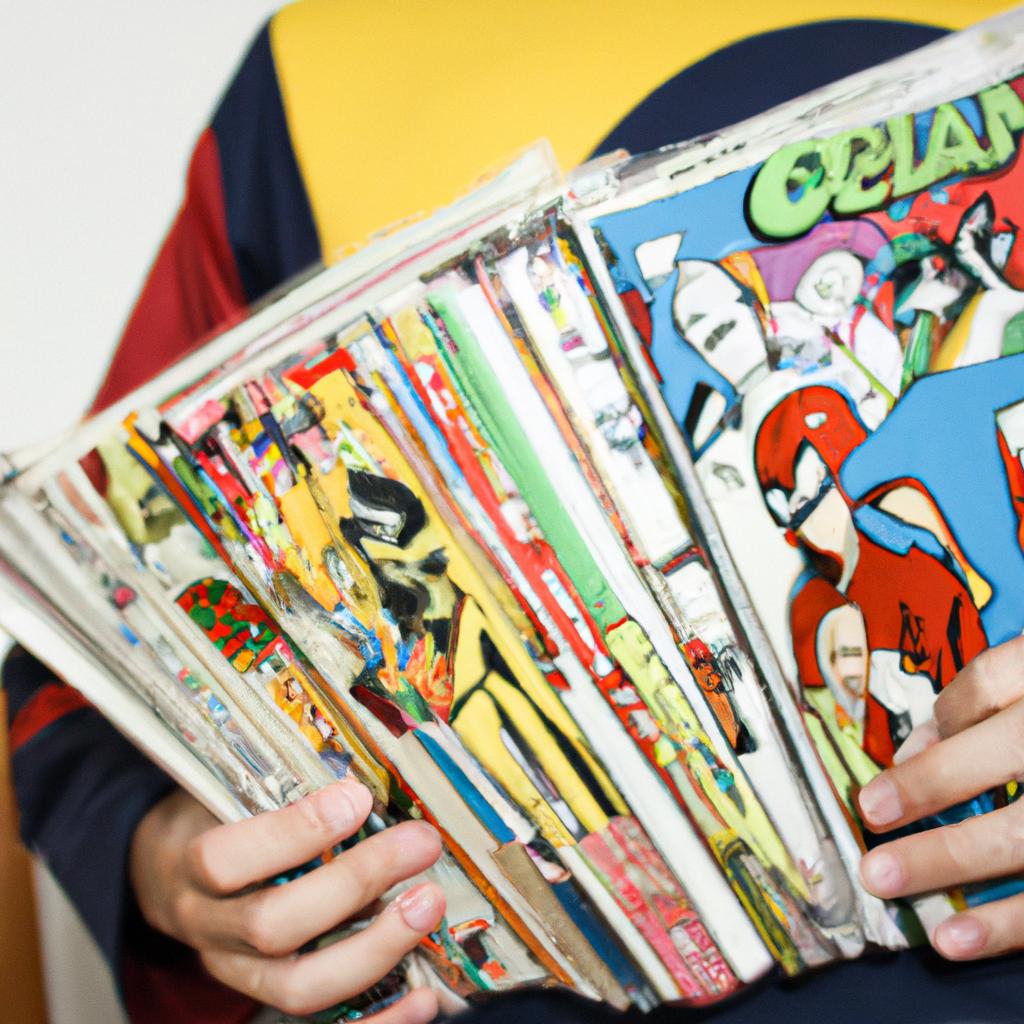Investing in Comic Books: An Antiques and Collectibles Guide

In recent years, the world of investing has expanded beyond traditional assets such as stocks and bonds. One area that has gained significant attention is comic books, which have evolved from mere entertainment to valuable collectibles with potential for substantial financial returns. For instance, consider the case of a rare copy of Action Comics #1, featuring the first appearance of Superman, which sold for an astonishing $3.2 million at auction in 2014 (Smithsonian Magazine, 2015). This example highlights the growing interest and market value associated with comic book investments.
This article serves as a comprehensive guide to navigating the realm of investing in comic books as antiques and collectibles. By exploring various aspects such as historical significance, rarity, condition grading systems, and market trends, readers will gain insights into how to make informed investment decisions within this unique alternative asset class. Additionally, we will discuss key considerations when buying and selling comic books, including preservation techniques and authentication processes. Whether you are an avid collector or a novice investor looking to diversify your portfolio, understanding the nuances of investing in comic books can potentially offer lucrative opportunities while also indulging in a hobby that celebrates creativity and storytelling.
Understanding the Comic Book Market
Comic books have become more than just a form of entertainment; they have evolved into highly sought-after collectibles. Investing in comic books can be an exciting and potentially lucrative endeavor for collectors and investors alike. By understanding the dynamics of the comic book market, individuals can make informed decisions and maximize their investment potential.
Consider the case of John, an avid collector who purchased a rare edition of Action Comics #1 for $0.10 back in 1938. Today, this comic book is valued at millions of dollars due to its significance as the first appearance of Superman. This example highlights how certain factors such as rarity, historical importance, and cultural relevance contribute to the value appreciation of comic books over time.
To gain a deeper understanding of the comic book market, it is essential to consider several key aspects:
- Rarity: The scarcity of a particular issue greatly influences its value. Limited print runs or unique variants often command higher prices within the market.
- Condition: The condition of a comic book significantly impacts its desirability and subsequent value. Factors such as creases, tears, discoloration, or restoration work can either enhance or diminish its worth.
- Popularity: Characters with enduring appeal tend to drive demand in the market. Superheroes like Batman or Spider-Man consistently attract collectors’ attention and maintain steady values.
- Cultural Significance: Comic books also reflect broader societal trends and milestones. Issues that tackle important social issues or represent breakthroughs in storytelling techniques hold significant value beyond mere monetary worth.
| Key Aspects | Explanation | Emotional Response |
|---|---|---|
| Rarity | Owning something scarce gives a sense of exclusivity | Excitement |
| Condition | Pristine conditions evoke feelings of preservation and care | Satisfaction |
| Popularity | Being part of a community that shares enthusiasm for beloved characters fosters connection | Belonging |
| Significance | Recognizing cultural milestones in comic books can evoke nostalgia and appreciation | Sentimentality |
Understanding the dynamics of rarity, condition, popularity, and cultural significance within the comic book market equips collectors with valuable insights. However, determining the value of comic books requires a more detailed assessment that takes into account these factors as well as market trends, grading standards, and other relevant considerations. By delving deeper into this process, individuals can make informed decisions when buying or selling their prized comic book collections.
Transitioning to the subsequent section about “Determining the Value of Comic Books,” let us explore how various factors contribute to assessing the worth of individual issues.
Determining the Value of Comic Books
Section 3: Assessing Comic Book Condition
When considering the value of a comic book, it is crucial to assess its condition accurately. A prime example that illustrates the significance of this evaluation is the case of Action Comics #1, published in 1938 and featuring the first appearance of Superman. In near-mint condition, this comic book can fetch millions at auction. However, if found in poor condition with creases, tears, or stains, its value diminishes significantly.
To determine the condition of a comic book effectively, collectors and investors rely on specific criteria:
- Cover Integrity: Examine the cover for any signs of wear such as folds, creases, tears, or color fading.
- Page Quality: Evaluate the pages for discoloration due to age or exposure to moisture.
- Spine Condition: Check if there are any stress marks or splits along the spine.
- Interior Defects: Look out for missing pages, writing, or excessive markings inside.
A helpful way to visualize these criteria is through a table showcasing different levels of comic book conditions:
| Condition | Description |
|---|---|
| Mint | Flawless copy without any visible defects |
| Near Mint | Minimal imperfections upon close inspection |
| Very Fine | Some minor wear but still overall excellent |
| Fine | Moderate wear and signs of aging |
| Good | Significant wear and potential damage |
| Fair | Heavy damage affecting readability |
| Poor | Severe damage rendering it almost unreadable |
By thoroughly evaluating a comic book’s condition using these guidelines and referring to industry grading standards like those established by CGC (Certified Guaranty Company), collectors can ensure they make informed investment decisions.
Transitioning into our next section about “Key Factors to Consider Before Investing,” understanding how to assess comic book condition is crucial in determining their potential value. By examining the market and evaluating condition, collectors can make strategic investment choices that align with their goals.
Key Factors to Consider Before Investing
Having understood the basics of comic book investment, it is now essential to delve into the process of determining their value. Let’s explore how collectors and investors assess the worth of these captivating pieces.
Determining a comic book’s value can be complex due to various factors that come into play. For instance, consider the case study of “Amazing Fantasy #15,” which introduced Spider-Man to the world in 1962. This issue holds great significance and rarity within the Marvel universe, making it highly sought-after by collectors. Its exceptional story, iconic cover art, and limited supply contribute to its immense value on the market today.
When assessing a comic book’s value, several key factors should be taken into account:
- Condition: The condition of a comic book plays a crucial role in determining its worth. Mint-condition copies with minimal wear and tear are more valuable than those with creases or torn pages.
- Rarity: The scarcity of a particular issue significantly impacts its value. Limited print runs or variants enhance collectability, as they become increasingly difficult to find over time.
- Popularity: High-demand characters or titles tend to have greater market appeal, driving up their prices. Icons like Batman, Superman, and X-Men often command higher values due to their enduring popularity among fans.
- Key Issues: Certain comic books feature pivotal events or first appearances that hold historical significance within their respective universes. Such key issues often fetch higher prices due to their importance in shaping the narrative trajectory.
To illustrate this further, let us examine the following table showcasing notable examples of valuable comics based on different genres:
| Genre | Comic Book Title | Estimated Value ($) |
|---|---|---|
| Superhero | Action Comics #1 | $3.2 million |
| Horror | Tales from the Crypt #17 | $1.2 million |
| Sci-Fi | Amazing Fantasy #15 | $795,000 |
| Crime/Mystery | Detective Comics #27 | $3.7 million |
As evident from the table, comic books across various genres can hold substantial value depending on their rarity and cultural significance.
By understanding the trends within different genres, investors can make informed decisions that align with their interests and financial goals.
Identifying Promising Comic Book Genres
Investing in Comic Books: An Antiques and Collectibles Guide
Now that we have established the importance of understanding key factors before investing in comic books, let’s delve deeper into this topic. To illustrate these factors, consider a hypothetical case study involving a collector named John who is looking to invest in comic books.
Firstly, it is essential to evaluate the condition of the comic book. Mint-condition comics tend to hold higher value compared to those with visible wear and tear. For instance, John discovers an issue of “Amazing Fantasy #15,” which features the first appearance of Spider-Man. Upon inspection, he notices that the pages are crisp, there are no creases or tears on the cover, and all staples are intact. This well-preserved copy significantly enhances its potential investment value.
Secondly, scarcity plays a vital role in determining a comic book’s worth. Comics printed in limited quantities or featuring rare variant covers often command higher prices due to their exclusivity. In our example, John stumbles upon a variant edition of “Action Comics #1” showcasing a unique cover art by a renowned artist. Given its limited print run of only 100 copies worldwide, this particular comic becomes highly sought after by collectors.
Thirdly, historical significance can greatly impact a comic book’s investment potential. Issues that mark significant events or introduce iconic characters tend to appreciate over time as they become cultural touchstones. Imagine if John were to come across an early issue of “Detective Comics #27” from 1939—featuring Batman’s debut—who wouldn’t recognize the immense historical value associated with such an item?
To summarize these key considerations:
- Condition: The better the condition, the higher the potential investment value.
- Scarcity: Limited editions or rare variants often fetch premium prices.
- Historical Significance: Issues that mark important moments or character debuts retain long-term value.
Analyzing these factors can help investors like John make informed decisions when entering the world of comic book investment. However, it is crucial to note that while these guidelines provide a foundation for evaluation, market trends and individual preferences may also influence decision-making.
In the upcoming section on “Building a Comic Book Collection,” we will explore practical steps to curate a collection aligned with your investment goals. So let’s move forward and discover how you can begin assembling an impressive assortment of comics with potential for future growth.
Building a Comic Book Collection
Once you have identified promising comic book genres, the next step is to start building your collection. To illustrate this process, let’s consider a hypothetical case study of an aspiring collector named Alex who wants to focus on superhero comics from the 1960s.
First and foremost, it is essential to establish a budget for your collection. Determine how much you are willing to invest in acquiring comic books and set aside funds accordingly. This will help guide your purchasing decisions and prevent overspending. Additionally, keep in mind that while some comic books may be relatively affordable initially, their value can increase over time. Being mindful of potential future appreciation can assist in making informed investment choices.
Next, create a plan for sourcing your desired comic books. Consider the following options:
- Local comic book stores: Visit nearby shops specializing in vintage and collectible comics. Engaging with knowledgeable store owners or staff members can provide valuable insights into locating specific issues.
- Online marketplaces: Explore reputable online platforms dedicated to buying and selling comic books such as eBay or specialized comic book websites.
- Conventions and trade shows: Attend local conventions or trade shows where dealers gather to showcase their collections. These events often offer opportunities to find rare or hard-to-find items.
To enhance your understanding of the market and make more informed purchases, research recent sale prices of similar comics through price guides or online databases. Understanding the current demand and pricing trends within the industry will enable you to identify potential bargains or avoid overpaying for certain issues.
Table: Factors Influencing Comic Book Values
| Factor | Impact |
|---|---|
| Rarity | Highly sought-after titles |
| Condition | Mint-condition copies |
| Popularity | Comics featuring popular characters |
| Historical significance | Key storylines or first appearances |
By considering these factors when evaluating potential acquisitions, collectors like Alex can make more informed decisions and maximize the value of their collections.
In summary, building a comic book collection requires careful planning, budgeting, and research. Establishing a budget and identifying reliable sources for acquiring comics are crucial steps in this process. Additionally, staying informed about market trends and factors that influence comic book values can enhance your ability to make strategic purchases. With these strategies in mind, you can begin assembling a collection that aligns with your interests and investment goals.
As you continue on your journey to becoming an astute collector, it is equally important to understand how to navigate the realm of selling comic books effectively. “.
Tips for Selling Comic Books
Having established the importance of building a comprehensive comic book collection, let us now explore some valuable tips on selling your acquired treasures.
To illustrate the potential profitability of selling comic books, consider the case study of John, an avid collector who decided to part ways with his prized possession—a rare copy of Action Comics #1. This issue, featuring the first appearance of Superman, is highly sought after by collectors worldwide due to its historical significance and scarcity. By utilizing effective strategies during the sales process, John managed to secure a substantial profit that exceeded even his wildest expectations.
Strategies for Successful Sales:
-
Research Market Trends:
Before listing your comic books for sale, it’s crucial to stay informed about current market trends. Keep track of recent auction results and monitor online platforms dedicated to buying and selling comics. Understanding which issues are currently in demand will help you price your collection competitively and attract potential buyers. -
Grade Your Comics Accurately:
Comic book grading plays a significant role in determining their value. Invest time in learning how to assess condition accurately or consult professional graders if necessary. Provide detailed descriptions and high-resolution photographs when advertising your comics for sale so that prospective buyers can make informed decisions based on visual evidence. -
Utilize Online Marketplaces:
Take advantage of online platforms specifically designed for buying and selling collectibles such as eBay, Heritage Auctions, or comic-specific websites like MyComicShop.com. These virtual marketplaces offer access to a vast network of potential buyers who share similar interests in comic book collecting. -
Engage with Local Communities:
While digital platforms provide global exposure, don’t overlook local opportunities within collector communities near you. Attend conventions or join comic book clubs to connect with enthusiasts who may be interested in purchasing your comics directly. Such interactions can also provide valuable insights and networking opportunities for future sales or trades.
Table: Comic Book Grading Scale
| Grade | Description |
|---|---|
| Mint | Perfect condition, no flaws or imperfections |
| Near Mint | Minor imperfections that are barely noticeable |
| Very Fine | Slight wear visible upon close inspection |
| Fine | Noticeable wear but overall intact |
Reasons to Sell Your Comics
- Financial gain: Selling rare and valuable comic books can yield substantial profits.
- Space management: Clearing out your collection allows room for new acquisitions.
- Focus on specific interests: Redirect funds toward other niche collectibles you’re passionate about.
- Sharing the joy: Passing on beloved comics to fellow enthusiasts ensures their preservation and appreciation by others.
By incorporating thorough research, accurate grading, online marketplaces, and local connections into your selling strategy, you increase the likelihood of a successful transaction when parting ways with your cherished comic books. Remember that every sale is an opportunity not only to profit but also to contribute to the thriving community of collectors worldwide.






